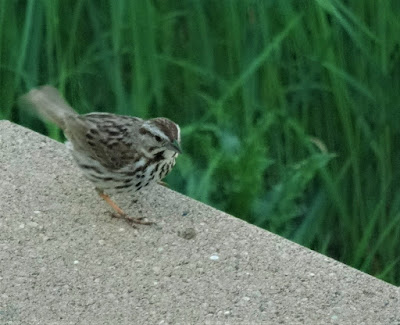6/17/2023
5/26/2023
song sparrow
Song Sparrow Melospiza melodia live up their binomial nomenclature 'melodia' by singing a delightful song, enthusiatically, and often.
They move along wetland edges like around the pond. I see the males occasionally, but they spend most of the time in dense, low vegetation.
5/22/2023
nest box Tree Swallows
Tree Swallows nest in cavities . . . old woodpecker holes in trees, or nest boxes. They do not go far south in winter; they return to Minnesota before any other swallows. They can eat plant foods, so they can survive before the insects come out. In the nest box near the pond, the Tree Swallow laid one egg each day in the last six days. She started incubating the eggs today. They will hatch in 11 to 20 days.
5/21/2023
1/30/2023
tree sparrow
American Tree Sparrows come to the feeders often in winter. Spizelloides arborea Tree Sparrows often fluff out their feathers. A rusty cap makes them look like chipping sparrows, who migrate south of Minnesota for winter. These little birds come 'south' to the northern US for winter. In spring, they breed in the far north tundra in Canada (near the tree line) building nests on the ground, often in a tussock of grass. They sport a rusty eyeline, a brown back, and dark smudge in the center of the smooth breast.
12/23/2022
sparrow
3/31/2022
eagle nest, March
11/23/2021
feederwatch 2021-2022
The pond is surrounded by grasses, wildflowers, and shrubs that provide food for birds. And we also put out seed and suet in feeders to bring the birds a little closer.
5/21/2021
hooded merganser ducklings
Today the Hooded Merganser female showed up on the pond with 15 ducklings. This species nests in a cavity, probably in a tree or stump nearby. Once the eggs hatch, the ducklings follow the mother to water. They fed for a while, then she signaled them to rest. They followed her to shore and gathered under her wings. Well, sort of . . . there were many of them!
They dive under water to find small fish, amphibians, clams, mud crabs, crayfish, tadpoles, frogs, and aquatic insects and other crustaceans. They also consume some aquatic plants.
5/20/2021
4/16/2021
dove on rock
The Mourning Doves Zenaida macroura spent winter near the pond in nearby bushes and tree cover. This one is celebrating Spring by investigating the water and rocks in the pond.
https://www.allaboutbirds.org/news/why-dont-birds-get-cold-feet/
https://www.birdnote.org/listen/shows/why-birds-feet-dont-freeze
12/28/2020
mourning doves
The seed feeders hang outside the deck railing. Sometimes the Mourning Doves line up on the rail, watching for their turn at the feeder. On some days they just sit here to crack and savor the seeds. We've seen ten at a time here, waiting or enjoying the food.
10/28/2020
water sports
Sunny and warmer, closer to normal weather today, after an early snow in October. Several Mallards are getting ready for their travel south by feeding on the dwindling supply of plant material in the pond. But the resident muskrats do not like to share their food supply. We watched several encounters today between the animals.
2/29/2020
Chickadees at feeder over the pond
Black-capped Chickadees stay in Minnesota all winter. They eat seeds and insects or larvae when they can find any. They come to feeders where I offer sunflower seeds, safflower seeds, and peanut chips. This feeder hangs over the pond with an extra branch for the birds to perch on.
From November to April I watch, count, and report the birds I see as a citizen scientist. Cornell Lab of Ornithology is replete with data and information about birds. https://www.birds.cornell.edu/home
This pond is covered with snow, and a layer of ice under that. The turtles are hibernating below in the mud. The muskrats are snug in their burrows. It looks quiet and peaceful on the pond, but there is a lot going on in all seasons.
10/24/2016
bird feeder garden
The veggie garden has been transitioned to a feeder garden for birds and pollinators. This year -- among the tomatoes, beans, peas, and squash -- I planted more native flowering plants. We watched as the nesting birds nearby brought their juveniles to the feeders and taught them how to feed themselves rather than gaping and begging. Now, with seed feeders and suet cages loaded, we'll start FeederWatch in a few weeks; we'll enjoy watching the birds that gather here and report our counts for ornithology research.















